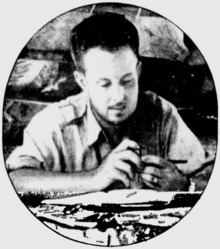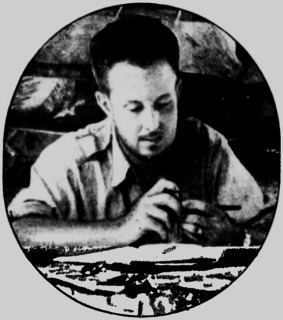Nationality American | Name Theodore Morde Spouse(s) Gloria E. Gustafson | |
 | ||
Occupation explorer, diplomat, and television news producer Known for Discovering the Lost City of the Monkey God Died 1954, Dartmouth, Massachusetts, United States | ||
El Mito de "La Ciudad Blanca"
Theodore A. "Ted" Morde (May 18, 1911 – June 26, 1954), an adventurer, explorer, diplomat, spy, journalist, and television news producer best known for his fabricated claim of discovering the "Lost City of the Monkey God".
Contents

Morde began his career as a radio announcer before getting into journalism. In 1940, he was hired to lead an expedition to search for the "Lost City of the Monkey God" in Honduras. After five months, he claimed to have found the city and brought thousands of artifacts back to the United States to prove it. He promised to return soon for a proper excavation, but never did, nor did he reveal the precise location of his find. It was revealed in the 2017 book "The Lost City of the Monkey God" by Douglas Preston that Morde never found any ruins and completely fabricated his story of having done so.
Morde spent the later years of his life as a diplomat, then a producer of news films. He took his own life in 1954. In 2013, Christopher S. Stewart wrote a book about Morde and his hunt for a legendary "lost city" that some have equated with la Ciudad Blanca.
Early life
Descended from whalers, Theodore A. Morde was born in New Bedford, Massachusetts on March 17, 1911. After graduating from New Bedford High School, he toured Europe.
Career
Morde got a job as a radio announcer for WNBH in New Bedford before taking special classes at Brown University from 1935-36. He then studied with the Hamilton Wright Agency to become a journalist. He later worked at radio stations in Pawtucket, Providence, and San Francisco.
As a journalist, he covered both sides of the Spanish Civil War in 1938. In 1942, he was a correspondent stationed with the British Eighth Army in Northern Africa during World War II. Around the same time, he served as general manager of Reader's Digest Near Eastern edition. In 1947, he covered the Arab side of the Palestine War.
Explorer
In 1940 George Gustav Heye hired Morde to lead an expedition to Honduras for the Museum of the American Indian. Two previous expeditions, performed by R. Stuart Murray, had turned up rumors of a lost city, which according to Murray the locals called the "Lost City of the Monkey God." In addition to searching for the city, Morde's expedition sought to study the indigenous people of the region, further explore known archaeological sites, and chart the upper reaches of the Wampú River.
After four months, Morde and his colleague, Laurence C. Brown, emerged from the forest and sent news of a great find. "'City of the Monkey God' is believed located: Expedition reports success in Honduras expedition" read the headline of the New York Times. When they returned to the states they brought thousands of artifacts to back their claim that they had found the lost city. They described their find as the capital of an agricultural civilization of the Chorotega people. Artifacts found included blades, a flute, sculptured idols, and stone utensils. Morde and Brown also reported seeing evidence of gold, silver, platinum, and oil in the region. According to Morde, flooding prevented formal excavation, but he planned to return in January 1941.
Morde went on to write a colorful travelogue of his experiences titled "In the Lost City of Ancient America's Monkey God" for The American Weekly. "I am convinced that we have found the site of the legendary Lost City of the Monkey God", he began the travelogue. He described "penetrating far into little known Mosquitia Territory" and warding off "malaria, deadly snakes, vicious insects and jungle beasts" before coming upon the ruins. "Towering mountains" flanked the "ideal setting" where he discovered a walled city with a monkey god that resembled Hanuman from Hindu culture. The temple of the god was not found, but local Paya guides described what it once looked like in detail allegedly passed down from their ancestors who had seen it.
When Morde asked his guides about the Monkey God, they told him a story of a monkey who had stolen three women. In a story, the monkey and the women bred and made half-monkey half-human children. The half-breeds were hunted three at a time for revenge. A similar story was later told to American anthropologist James Taggart by Nahuat speakers.
According to the stories Morde was told, the monkey god was once worshipped with human sacrifice by Chorotega people. He also described a "Dance of the Dead Monkeys", a still practiced "perverted memory of that old form of worship", according to Morde. In great detail he describes how hunters kill three monkeys apiece and put them in the fire to "dance" as the heat makes their muscles contract. He describes a second legend, "the Sacred Bird of the Chorotegans", where a beautiful queen was changed into a Margarita bird by an evil god Wampai.
Morde never did return to Honduras, or reveal the precise location of his find. His city has been associated with the legend of la Ciudad Blanca in the Mosquitia region of eastern Honduras. "The Lost City of the Monkey God" by Douglas Preston revealed that Morde fabricated most of his claims about finding a lost city. Morde's own journals, obtained by Preston, show that he never found any significant ruins and made up his stories of having done so, having spent most of his time in Honduras looking for gold.
Diplomat
Morde also had ties to the OSS, and received a bronze star medal for actions in Ankara, Turkey 1943 as a Lieutenant, junior grade. After World War II, he served as a special adviser to the Egyptian Premier for the US government, and as adviser to the Egyptian Ambassador in Washington, D.C.
Later in life, Morde founded Theodore Morde, Inc. to produce news films, and served as the president of Spot News Productions.
Personal life
Morde was married to Gloria E. Gustafson, a model employed by the John Robert Powers Agency. The couple had two children—Christine and Theodore. Morde had a brother and a sister, and was an avid traveler.
Death
On June 26, 1954, Morde was found hanging from the shower stall of his parents' home in Dartmouth, Massachusetts. His death was ruled a suicide by the medical examiner. Conspiracy theorists later asserted sinister forces were behind his death. Some normally reliable sources written much later report that Morde had been run over by an automobile in London, England "shortly" after his expedition to Honduras.
Jungleland
In 2013, journalist Christopher S. Stewart wrote a book titled Jungleland about the legend of la Ciudad Blanca and Morde. He went to Honduras and undertook an expedition with archaeologist Christopher Begley in 2008 where he attempted to retrace Morde's steps using his original field journals. Stewart interviewed Morde's surviving family members and provided an account of his life. In 2015 archeologists discovered a "lost city" in the region, thought to be associated with the civilization discovered by Morde. At the scientists' urging, the Honduran government dispatched army forces to protect the site from looters.
